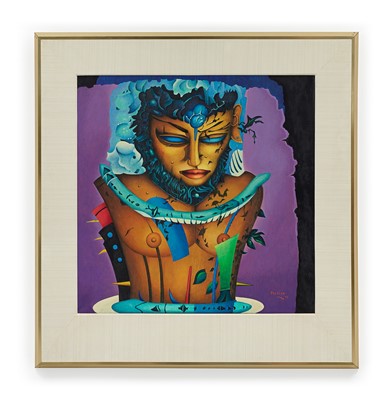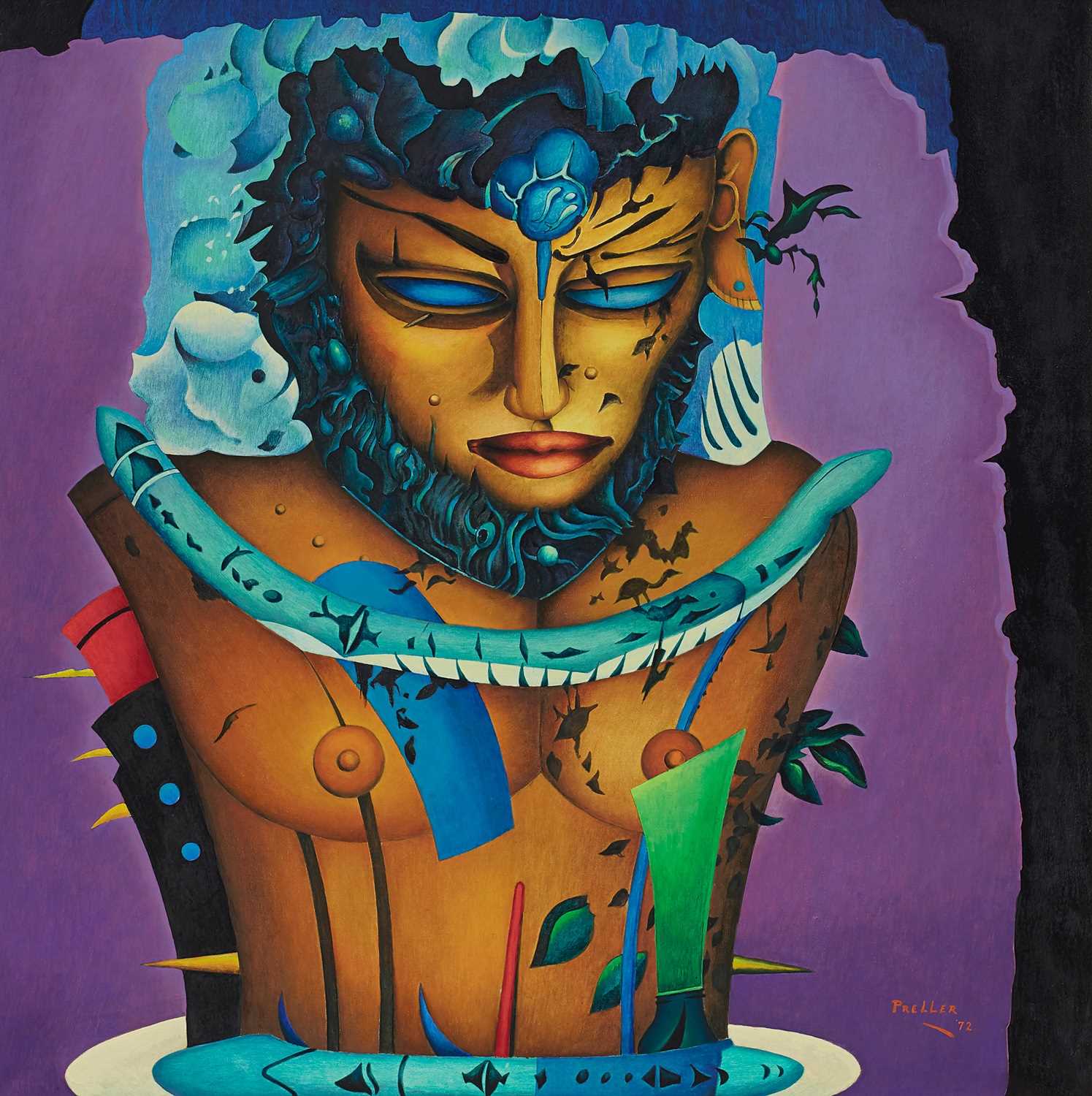28th Oct, 2018 8:30
Historic, Modern and Contemporary Art
103
Alexis Preller (South Africa 1911-1975)
Adam
oil on canvas
Artwork date: 1972
Signature details: signed and dated
Exhibited: Biennale of São Paulo, Brazil, 1973.
Literature: Berman, E. and Nel, K. (2009). Alexis Preller: Collected Images. Johannesburg: Shelf Publishing, a comparable example titled Icon Barbare (Adam) illustrated on p.230.
Sold for R9,104,000
Estimated at R8,000,000 - R10,000,000
oil on canvas
Artwork date: 1972
Signature details: signed and dated
Exhibited: Biennale of São Paulo, Brazil, 1973.
Literature: Berman, E. and Nel, K. (2009). Alexis Preller: Collected Images. Johannesburg: Shelf Publishing, a comparable example titled Icon Barbare (Adam) illustrated on p.230.
(1)
102 x 102 cm
Notes:
On first encountering this electrifying and vibrant painting by Alexis Preller from 1972, one is immediately struck by its hypersaturated colour palette. Simply titled Adam, it belongs to a period in Preller’s career where the figuration of male subjects was taking interesting directions and nuances. As was often Preller’s practice, he painted several versions of and variations on the Adam theme through the late 1960s and early 1970s. As Berman and Nel (2009)1 point out, much of the importance of this work derives from its status as a variation on a significant original Adam intaglio from 1969. Initially thought to be lost, this earlier work was subsequently rediscovered in a private collection in the USA and returned to South Africa. The almost lifesize fibreglass and oil intaglio depicts a powerfully dramatic male figure, posed in the ancient Greek kouros style of a free-standing young male nude statue with arms at his sides, though Preller’s is without arms, and has a direct and unmistakably sexualised presence. With this work, along with the two paintings The Creation of Adam I and The Creation of Adam II, Preller thus inaugurates in the late 1960s a series of Adamic figures that might be grouped with the Apollonian torsos that find their best expression in the magisterial Marathon of 1970. As Berman and Nel (2009)2 explain:[Preller was now focused on] the Biblical myth of the origin of humankind and the parallel return to the origin of his own creative language. In both cases, the focus fell on Adam, the first human figure to be shaped in the Garden of Eden… Adam was specifically the first man and thus the essential male prototype, just as Apollo was the ideal of male beauty. […] Preller freelycelebrated both (emphases in original).
The current work on auction fits exactly within this group, and demonstrates many of the key characteristics of Preller’s imagining of the male psyche in his oeuvre and in his personal mythography. In the Adamic and Apollonian works around this time there is often a gender ambiguity, and a certain eroticism, which this Adam figure embodies.As a painted study, or a revisioning, of the 1969 intaglio, it retains the aura of a Pan figure, or a Satyr. In antiquity these Satyrs expressed qualities of sexuality and power, but also of the religious or sacred properties with which ancient societies imbued nature. They were in essence pagan or pantheistic societies. The elements that are retained in this Preller painting from the earlier intaglio reinforce this impression – the mane of hair and beard, and the belt and neck decorations, for example – both connect the work to the other Apollonian studies and lend it an air of pagan pantheism, elements Preller was aware of and seeking to express in his own way. Another Adam work from the same year as the current painting, Icon Barbare (Adam) (1974), referenced in Berman and Nel,3 evokes the same qualities, though realised in gold leaf on wood. Clearly the most striking aspect of this important work is its startling colour palette in almost kaleidoscopic purples, blues and greens. It is a very different and extreme contrast to the far more muted palettes of the other Adams, and brings it more in line with later paintings like C’est magnifique (1974). This Adam’s eyes are rendered in a powerfully uncanny electric blue, lending the figure an almost reverential and godlike atmosphere. They are completely blue, painted without irises, in an allusion to classical Greek sculpture. Preller imbues his Adam with this timeless quality, as if he is looking into the void, capturing powerfully the ambiguity beween the abyss and a godlike expansiveness. It was certainly telling that Preller deemed it a significant enough work to go to the São Paulo Biennale of 1973, an exhibition for which he only selected five works.
James Sey
Sources:
1 Berman, E. and Nel, K. (2009). Alexis Preller, A Visual Biography: Collected
Images. Johannesburg: Shelf Publishing, p.229.
You can place an absentee bid through our website - please sign in to your account on our website to proceed.
In the My Account tab you can also enter telephone bids, or email bids@aspireart.net to log telephone/absentee bids.
Join us on the day of the auction to follow and bid in real-time.
The auction will be live-streamed with an audio-visual feed.
Auction: Historic, Modern and Contemporary Art, 28th Oct, 2018
Aspire Art Auctions brought a significant double-header of top lot leads to this sale.
Stellar results were achieved for internationally prominent William Kentridge and Alexis Preller, one of South Africa’s most respected and collectable modern artists. Collectors were attracted to Kentridge’s remarkable, Drawing from Stereoscope (Double page, Soho in two rooms) (1999), which sold for R6 600 400, while Preller’s Adam (1972), sold for a world record at R9 104 000. Modern offerings also included works by Peter Clarke, Kenneth Bakker, and Douglas Portway, while the contemporary segment included Moshekwa Langa, Penny Siopis, Simon Stone, Clive van den Berg, and Georgina Gratrix, amongst others.
IMPORTANT NOTICE:
Logistics
While we endeavour to assist our Clients as much as possible, we require artwork(s) to be delivered and/or collected from our premises by the Client. In instances where a Client is unable to deliver or collect artwork(s), Aspire staff is available to assist in this process by outsourcing the services to one of our preferred Service Providers. The cost for this will be for the Client’s account, with an additional Handling Fee of 15% charged on top of the Service Provider’s invoice.
Aspire Art provides inter-company transfer services for its Clients between Johannesburg and Cape Town branches. These are based on the size of the artwork(s), and charged as follows:
Small (≤60x90x10 cm): R480
Medium (≤90x120x15 cm): R960
Large (≤120x150x20 cm): R1,440
Over-size: Special quote
Should artwork(s) be collected or delivered to/from Clients by Aspire Art directly, the following charges will apply:
Collection/delivery ≤20km: R400
Collection/delivery 20km>R800≤50km
Collection/delivery >50km: Special quote
Packaging
A flat fee of R100 will be added to the invoice for packaging of unframed works on paper.
International Collectors Shipping Package
For collectors based outside South Africa who purchase regularly from Aspire Art’s auctions in South Africa, it does not make sense to ship artworks individually or per auction and pay shipping every time you buy another work. Consequently, we have developed a special collectors’ shipping package to assist in reducing shipping costs and the constant demands of logistics arrangements.
For buyers from outside South Africa, we will keep the artworks you have purchased in storage during the year and then ship all the works you have acquired during the year together, so the shipping costs are reduced. At the end of the annual period, we will source various quotes to get you the best price, and ship all your artworks to your desired address at once.
Aspire Art will arrange suitable storage during, and cost-effective shipping at the end, of the annual period.
Collections
Collections are by appointment, with 24-hours’ notice
Clients are requested to contact the relevant office and inform Aspire Art of which artwork(s) they would like to collect, and allow a 24-hour window for Aspire Art’s logistics department to retrieve the artwork(s) and prepare them for collection.
Handling Fee
Aspire Art charges a 15% Handling Fee on all Logistics, Framing, Restoration and Conservation arranged by Aspire.


